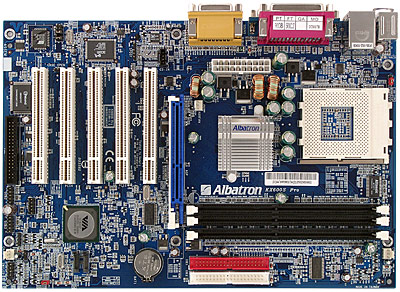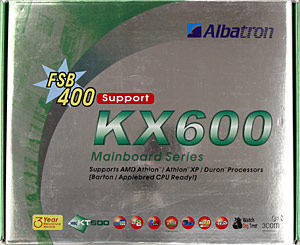Albatron KX600S Pro Motherboard on VIA KT600
|
Reviewing KX600
Pro, we pointed
out that despite a soldered VT8237 south bridge, the model was
as functional as the old VT8235 (the reason for which remained not
completely clear). Now, a year after that, Albatron finally announces
a KT600-based board with a full functionality of the corresponding
south bridge.

The problem with most narrow boards is that the more compact they are, the less convenient their layout is. It will be rather difficult to access the board once we connect the cables to the FDDs (it blocks the left marginal area), the Audio-Ins before the PCI slots (it can cause problems with extension cards), and the IDEs (the cables will run over the DIMMs that will also be blocked in their sockets because of the AGP card installation). The clear CMOS jumper is easily accessible even after the board is installed. However, you'll hardly be able to reach the jumper to enable/disable OTP (luckily, you'll rarely need to disable CPU over-temperature protection). The PCB contains a brief description of both jumpers' functionality.
The +5 V Standby is indicated by a red LED. The dual-channel CPU voltage regulator has 8 2200µF capacitors. The board also houses voltage regulators of the AGP bus (1 x 1000µF and several less capacious ones)
and the memory (1 x 1000µF and several less capacious ones). The board measures 305x200 mm (a narrowed ATX, six-screw mount, an additional fixation needed for the front edge).
A Winbond
W83697HF
chip is used to monitor:
- CPU and battery voltage, +3.3, +5, ±12 V, and +5 V Standby;
- RPM of 2 fans;
- CPU and board temperatures (using corresponding embedded sensors).
The board has no unsoldered elements while the KX600S model lacks a LAN controller and a connector for it. All previous Albatron KT600/KT400A/KT400-based boards have similar PCBs with minor differences (such as a place for SATA connectors, etc.). KX600S/Pro is completely identical to KX600/Pro version 3.0 in terms of supplied optional controllers (the AC'97 codec has been changed from Realtek ALC650 to ALC655 and the LAN controller from 3Com 910 to 920 since the first revisions).
Onboard ports, sockets, and connectors
- CPU Socket 462(A);
- 3 x DDR SDRAM DIMM (up to 3 GB DDR266/333/400, not more than two dual-side modules, one of which should be installed into the third connector);
- 1 x AGP (with a clip);
- 5 x PCI;
- Standard ATX (no additional 12 V connector);
- 1 x FDD;
- 2 x IDE (Parallel ATA) in the chipset;
- 2 x SATA (Serial ATA) in the chipset, possibility to organise RAID 0 or 1 from the connected discs;
- 3 connectors for brackets each with 2 additional USB (2.0) ports;
- 1 x CD/DVD audio connector;
- 1 x CI sensor connector;
- Headers for additional Audio-Outs and S/PDIF;
- 3 x fan connectors (2 of them enable RPM control).
Back panel (left to right, blockwise)

- PS/2 mouse and keyboard;
- 2 x USB and 1 x RJ-45 (Fast Ethernet);
- 1 x LPT, 2 x COM;
- 3 x Ausio (Mic-In, Line-In, Front) and 1 x Game.
The back panel is standard and requires no special I/O shield.
Bundle

- Standard design box covered with glassy pellicle;
- Documentation: user manual in 4 languages;
- Cables: 1 x Serial ATA (with a PCPlug-SATA power adapter), 2 x ATA66/100/133, 1 x FDD;
- PC Back panel strap with 4 x USB;
- CD with software:
- necessary drivers;
- Adobe Acrobat Reader;
- PC-cillin 2002;
- DirectX 9.0b.
Integrated controllers
- Realtek ALC655 AC'97 5.1 codec based audio controller with front Audio I/O and S/PDIF connectors;
- 3Com Marvell 920-MV00 based LAN controller supporting 10/100 Mbit/sec Base-T (Fast Ethernet).
The integrated audio quality was tested in 16 bits, 44 kHz, using the RightMark
Audio Analyzer 5.2 test program and the Terratec
DMX 6fire sound card:
| Frequency
response (40 Hz to 15 kHz), dB: |
+0.33, -0.20
|
Good
|
| Noise level,
dB (A): |
-86.6
|
Good
|
| Dynamic range,
dB (A): |
86.4
|
Good
|
| THD, %: |
0.042
|
Good
|
| IMD, %: |
0.070
|
Good
|
| Stereo crosstalk
, dB: |
-85.1
|
Excellent
|
Total: Good (details).
The result is quite satisfactory: there are no flops and the integrated
sound can substitute an inexpensive external card.
Proprietary technologies
- OTP (CPU Over Temperature Protection that uses a precise temperature value from the integrated thermal sensor).
Settings
| Jumpers and switches |
Clear CMOS jumper |
The board fixes an impossible
boot caused by overclocking, and clears CMOS |
| Jumper to enable/disable OTP |
|
| BIOS, based on Phoenix's AwardBIOS
version 6.00PG |
Memory timings |
+ |
CAS Latency, Precharge to Active, Active
to Precharge, Active to CMD, Command Rate |
| Memory frequency selection |
+ |
By SPD, DDR/CPU = 2.66x at FSB =100 MHz,
DDR/CPU = 2.0x, 2.5x, 3.0x at FSB = 133 MHz, DDR/CPU = 1.6x, 2.0x,
2.4x at FSB = 166 MHz, DDR/CPU = 1.33x, 1.66x, 2.0x at FSB = 200
MHz |
| AGP bus setup |
+ |
|
| PCI bus setup |
+ |
|
| AGP/PCI frequency divider setup |
+ |
CPU:AGP(PCIx2) = 3:2, 4:2, 5:2, 6:2 |
| PCI IRQ manual assignment |
+ |
|
| FSB frequency setup |
+ |
100—248 MHz at 1MHz increments |
| CPU multiplier |
- |
x5—x24 |
| CPU core voltage control |
+ |
Auto, 1.2—2.1 V at 0,025V increments
|
| Memory voltage control |
+ |
Auto, 2.65, 2.7, 2.75, 2.8 V |
| Chipset voltage control |
- |
|
| AGP voltage control |
+ |
Auto, 1.6, 1.7, 1.8 V |
We used BIOS R1.06, the latest available version for the moment of testing.
The mentioned BIOS parameters are available in the version, but the viability of non-standard settings hasn't been tested. In version R1.08, we have corrected the mistake related to HDD formatting under DOS.
Performance
Our preliminary testing shows that the model is the slowest among the mentioned ones based on the chipset. The lag from the best-scoring KT600-based boards is 4-6 percent in tests that are the most sensitive to memory subsystem performance.
| Test |
ABIT KV7 | Albatron KX600S Pro |
| Memory read speed (CacheBurst32), MB/s |
1569 | 1367 |
| Memory write speed (CacheBurst32), MB/s |
869 | 735 |
| Memory read latency (CacheBurst32), clocks |
213 | 234 |
| 7-Zip archiving, min:sec |
11:15 | 11:44 |
| WinRAR archiving, min:sec |
4:01 | 4:18 |
Test results:
This model on the manufacturer's site
Write a comment below. No registration needed!
|
|
 |
|
|
|



